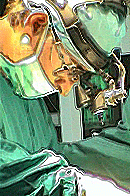OLIGODENDROGLIOMAS
Oligodendrocytes maintain
myelin and hover obediently about large neurons in the
cerebral cortex. They occur, therefore, in both gray matter
and white matter but are much more numerous in the latter,
where they are regimented along axis cylinders. Neoplasms
derived from these cells are found principally in adults and
primarily in the
cerebral hemispheres, where the frontal lobes are greatly
favoured. Only rarely does an oligodendroglioma appear in the
cerebellum, brain stem, or spinal cord. Radiographic
calcification is common. Seizures may be present for many
years preoperatively.
At surgery, the lesions are
infiltrating tumors and therefore can resemble the
well-differentiated astrocytoma. Focally, however, the
neoplasm is often extremely cellular, gray, and fleshy, so
it can simulate an anaplastic neoplasm. Heavy calcification
in a cerebral neoplasm in an adult should alert the surgeon
and the pathologist to the possibility of this entity,
particularly if the mineralization occurs in a sinuous "gyriform"
pattern.
The oligodendroglioma has a number of distinctive histologic
features that usually permit a ready and unequivocal
diagnosis in permanent sections, although the neoplasm can
be difficult to recognize in frozen tissues.
The nuclei are monotonously round and uniform, and are
packed into cellular sheets that abut rather abruptly on the
adjacent brain. In zones of cortical infiltration, perineuronal satellitosis is often more pronounced than in
astrocytomas.
Calcification is common as freestanding laminated bodies (calcospherites)
or mineralization of blood vessel walls. The
presence of delicate angulated segments of capillaries that
parenthesize focal areas of the parenchyma is an additional
vascular change. Vascular cells commonly proliferate in the
oligodendroglioma, although not usually in the marked glomeruloid formation as noted in glioblastoma. Such
vascular cell proliferation may be present in even the
well-differentiated lesion, where it does not necessarily
have malignant connotations.
The most distinctive and
diagnostic feature of the oligodendroglioma
is an artefact due to its propensity for imbibing water
during ischemia or autolysis. When this fluid
distends the cytoplasm, the bloated cells contain lucent
perinuclear halos resembling the whites of fried eggs about
their yolks. As diagnostically helpful as it is
aesthetically pleasing, this artefact is, unfortunately, not
present in tissues that are fixed rapidly, particularly
those used for frozen sections. The presence of this
artefact constitutes the one, and probably the only,
occasion when a pathologist is pleased that tissues are
transported in the physiologic but autolysis-promoting warm
saline to which neurosurgeons occasionally entrust excised
tissue.
The classic oligodendroglioma is readily recognized in
permanent section, although the absence of the
characteristic halos in frozen sections may make recognition
of this neoplasm difficult during surgery. Such a lesion may
be interpreted as an astrocytoma or, because of its high
cellularity, an anaplastic astrocytoma. The presence of
sheets of high cellularity, monotonous nuclear roundness,
calcium, and the typical vascular formations at this point
are all suggestive features. If difficulty persists in
permanent sections, the GFAP method can be extremely
helpful, because oligodendroglia contain microtubules
rather than glial filaments. In concept, the oligodendrocyte is therefore negative with this technique.
Nevertheless, GFAP-positive cells are observed in many
oligodendrogliomas. Four distinct types of such cells have
been identified: (1) entrapped reactive astrocytes, (2)
neoplastic fibrillary astrocytes (which, if present in
significant numbers may warrant a diagnosis
of mixed glioma), (3) cells with the appearance
of miniature gemistocytes ("minigemistocytes"), and (4)
"gliofibrillary
oligodendrocytes," which resemble typical oligodendrocytes
in all respects except for a thin rim of GFAP-positive
cytoplasm surrounding the nucleus. Both the "minigemistocytes"
and "gliofibrillary oligodendrocytes" have been considered
transitional cell types expressing an intermediate
phenotype between the oligodendrocyte and the astrocyte.
A recent study suggests that there is no prognostic
significance to the presence of either cell type in an
otherwise typical oligodendroglioma. The
presence of large, classic gemistocytic astrocytes,
however, was a negative prognostic factor, as would be
expected for a mixed oligoastrocytoma with an anaplastic
astrocytic component.
The typical oligodendroglioma
described above merges with a continuum of increasingly
cellular and pleomorphic lesions. Several
four-tiered systems have been used for grading
oligodendrogliomas. A recent study suggests,
however, that for prognostic purposes, the spectrum of
oligodendrogliomas best stratifies into only two groups, low
grade and high grade. The high-grade lesions
are characterized by histologic features typically
associated with a poor prognosis, including microvascular
proliferation, foci of necrosis, and significant mitotic
activity. A rare lesion may exhibit
mixed features of both high-grade (anaplastic)
oligodendroglioma and glioblastoma multiforme; such lesions
are difficult to classify (malignant oligodendroglioma
versus glioblastoma). The importance of distinguishing
between high-grade oligodendroglioma and glioblastoma lies
in the fact that even the most anaplastic oligodendrogliomas
generally have a better prognosis than that of
glioblastoma.



